GLOBAL MARKETS-Equities mixed as investors eye earnings; yen on intervention watch
I believe they want to tighten financial conditions by communicating a further distance is required for cuts, but they can do those cuts at whatever speed is necessary," said Jamie Cox, managing partner for Harris Financial Group in Richmond, Virginia. INTERVENTION ZONE The drastic shift in rate expectations has elevated Treasury yields and lifted the dollar in the past few weeks, with pressure felt particularly in Asia. In the latest illustration, Indonesia's central bank delivered a surprise rate hike on Wednesday, stepping up efforts to support the rupiah currency.

- Country:
- United States
U.S. and European shares finished mixed on Wednesday ahead of more corporate earnings this week, and the yen was mired near 34-year lows, keeping traders wary of intervention from Japan. An auction of a record $70 billion worth of five-year U.S. Treasury notes on Wednesday helped to push bond yields higher, pressuring equities.
MSCI's gauge of stocks across the globe rose 1.31 points, or 0.17%, to 759.46. On Wall Street, the S&P 500 closed slightly higher after choppy trading.
Europe's broad STOXX 600 index closed down 0.5% as financial stocks dragged the index off a more than one-week peak. The S&P 500 gained 1.08 points, or 0.02%, to 5,071.63 and the Nasdaq Composite gained 16.11 points, or 0.10%, to 15,712.75. The Dow Jones Industrial Average fell 42.77 points, or 0.11%, to 38,460.92.
"This week is getting back to market fundamentals and earnings. At least temporarily, we are sidestepping geopolitics which have been impacting markets in the last two weeks," said Samy Chaar, chief economist at Lombard Odier. Spot gold continued its slide, trading down 0.26% to $2,315.82 an ounce. U.S. gold futures settled 0.2% lower at $2,338.4.
DATA DIVERGENCE Purchasing Managers Index surveys on Tuesday showed overall business activity in the euro zone and in Britain expanded at their fastest pace in nearly a year, while business activity cooled in the U.S.
That divergence helped the euro nudge above $1.07 in Asia trade, its highest in more than a week. "For once, US-eurozone divergence in data has come to the benefit of euro/dollar," said Francesco Pesole, currency strategist at ING, in a note.
"(Though) hard data - inflation and employment above all - has been the real drag on the pair so far, so caution is warranted when it comes to rallies prompted by activity surveys like PMIs." U.S. gross domestic product and March personal consumption expenditure data due later this week will be crucial for the dollar and for investors' attempts to gauge the path of U.S. rates.
Traders expect the Federal Reserve to start easing rates in September and ending the year with 42 basis points of cuts, down from previous bets for 150 bps. "One thing is fore sure: the Fed is not raising rates. I believe they want to tighten financial conditions by communicating a further distance is required for cuts, but they can do those cuts at whatever speed is necessary," said Jamie Cox, managing partner for Harris Financial Group in Richmond, Virginia.
INTERVENTION ZONE The drastic shift in rate expectations has elevated Treasury yields and lifted the dollar in the past few weeks, with pressure felt particularly in Asia.
In the latest illustration, Indonesia's central bank delivered a surprise rate hike on Wednesday, stepping up efforts to support the rupiah currency. The Japanese yen weakened 0.09% against the greenback at 154.95 per dollar and touched its lowest since 1990 ahead of the Bank of Japan's two-day policy meeting that concludes on Friday.
A senior official of Japan's ruling party told Reuters they were not yet in active discussion on what yen levels would be deemed worthy of market intervention. The benchmark 10-year Treasury note rose five basis points to 4.6459%.
In commodities, Brent crude futures fell 40 cents, or 0.45%, to settle at $88.02 a barrel, while U.S. West Texas Intermediate crude futures slipped 55 cents, or 0.66%, to $82.81.
(This story has not been edited by Devdiscourse staff and is auto-generated from a syndicated feed.)
ALSO READ
Pakistan police kill bomber, militant to thwart attack on Japanese nationals
Two killed in suicide bomb attack on vehicle carrying Japanese nationals in Pakistan
Five Japanese escape unhurt in Pakistan suicide blast attack
Five Japanese nationals escape Pakistan suicide blast attack
Five Japanese survive Pakistan suicide bomber and gunman attack, two bystanders killed










